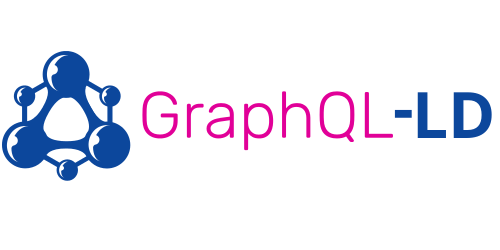SOCOM Tutorial Slides - GraphQL-LD

GraphQL is a highly popular
data query language
Input:
{
people {
name
height
}
}
Output:
{
"data": {
"people": [
{ "name": "Victor Gilbert", 1.8 },
{ "name": "Scarlett Nixon", 1.65 },
{ "name": "Axel Blackburn", 1.82 }
]
}
}

GraphQL pros and cons
Pros:
- Simple syntax: WYSIWYG
- Many tools are available
- Large amount of tutorials and documentation
Cons:
- No global semantics: queries are tied to server schemas
- No global identifiers: queries are tied to server data
- Federated querying is hard
GraphQL-LD enhances GraphQL with RDF

-
Applies a JSON-LD context to GraphQL queries
Query fields are converted to URIs
-
Converts queries to SPARQL
Hierarchies to chained triple patterns
-
Executes SPARQL query
Any SPARQL engine can be used. E.g. Comunica
-
Converts SPARQL results to JSON
Same shape as the input query
Simple GraphQL-LD example
GraphQL query:
{
name(_:"The DBpedia Ontology")
description
}
JSON-LD context:
{ "name": {
"@id": "dct:title",
"@language": "en"
},
"description": "dct:description"
}
Resulting SPARQL query:
SELECT ?description WHERE {
_:b1 dct:title "The DBpedia Ontology"@en.
_:b1 dct:description ?description.
}
Functionality: Overview
-
Fields and nesting
Create chained triple patterns
-
Arguments
Set objects in triple patterns
-
Inline fragments
Define optional typed blocks
-
Pagination
Apply offset and limit
Fields and nesting
Nodes can be nested to any depth, and just produce more triple patterns.
GraphQL:
{
hero {
name
friends {
name
}
}
}
SPARQL:
SELECT ?hero_name ?hero_friends_name WHERE {
_:b1 ex:hero ?hero.
?hero ex:name ?hero_name.
?hero ex:friends ?hero_friends.
?hero_friends ex:name ?hero_friends_name.
}
Arguments
Node arguments are converted to triple objects in SPARQL.
GraphQL:
{
human(id: "1000") {
name
height
}
}
SPARQL:
SELECT ?hero_name ?hero_friends_name WHERE {
_:b1 ex:hero ?hero.
?human ex:id "1000".
?human ex:name ?human_name.
?human ex:height ?human_height.
}
Inline fragments
Inline fragments can be used to scope an (optional) block to a certain type.
GraphQL:
{
hero {
name
... on Droid {
function
}
... on Human {
height
}
}
}
SPARQL:
SELECT ?hero_name ?hero_function ?hero_height
WHERE {
_:b1 ex:hero ?hero.
?hero ex:name ?hero_name.
OPTIONAL {
?hero rdf:type ex:Droid.
?hero ex:function ?hero_function.
}
OPTIONAL {
?hero rdf:type ex:Human.
?hero ex:height ?hero_height.
}
}
Singularization
Only select a single value, instead of multiple.
Output singularized:
[
{
"name": "Alice"
},
{
"name": "Bob"
}
]
Output non-singularized:
[
{
"name": [ "Alice", "Al" ]
},
{
"name": [ "Bob", "Bobby" ]
}
]
Singularization scoping
Singularization can be scoped to a single field, to all fields, or can be reversed
GraphQL:
query @single(scope: all) { # Makes all fields singular by default
hero @plural { # Makes only this field plural
name
}
}
More advanced features
All features are listed on https://github.com/rubensworks/graphql-to-sparql.js
- Meta fields: Easily getting the
rdf:type of something.
- Named graphs: Getting or setting the named graph of a block.
- Optionals: Mark a block as
OPTIONAL.
- Reversing: Reverse predicate direction.
- Alternatives: Include alternative predicates, like in SPARQL property paths.
- ...
Getting started with GraphQL-LD
Conclusions
-
GraphQL-LD lifts GraphQL queries to the RDF world
by applying a JSON-LD context
-
Queries are converted to SPARQL
Queries can be structured via arguments, JSON-LD features, directives
-
GraphQL-LD is open source
Can be used in any JavaScript application (Node.js, browser)
